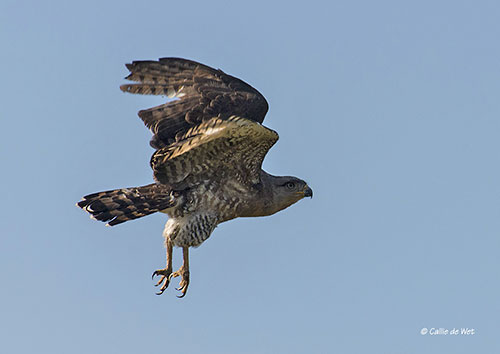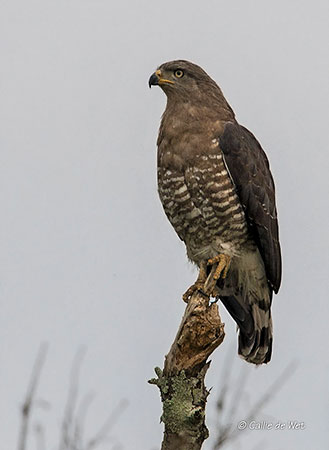
Fr: Circaète barré
Ang: Southern Banded Snake Eagle
All: Graubrust-Schlangenadler
Esp: Culebrera barrada
Ita: Biancone fasciato
Nd: Grijze Slangenarend
Sd: kustormörn
Photographers:
Callie de Wet
GALLERY
Dubi Shapiro
Dubi Shapiro Photo Galleries
Text by Nicole Bouglouan
Sources:
HANDBOOK OF THE BIRDS OF THE WORLD Vol 2 by Josep del Hoyo-Andrew Elliot-Jordi Sargatal - Lynx Edicions - ISBN: 8487334156
BIRDS OF AFRICA SOUTH OF THE SAHARA by Ian Sinclair and Peter Ryan - Princeton University Press Princeton and Oxford - ISBN: 0691118159
BIRDS OF PREY OF AFRICA AND ITS ISLANDS by Alan and Meg Kemp - Struik Publishers - ISBN: 1770073698
ROBERTS BIRDS OF SOUTH AFRICA by G. R. Mc Lachlan and R. Liversidge – The Trustees of the John Voelcker Bird Book Fund – ISBN: 0620031182
BIRDS OF SOUTHERN AFRICA – By Ian Sinclair, Phil Hockey and Warwick Tarboton – Princeton Field Guides - Princeton and Oxford – ISBN: 0-691-09682-1
Global Raptor Information Network - Working to Conserve Birds of Prey in nature
Wikipedia, the free encyclopaedia
Southern Banded Snake Eagle
Circaetus fasciolatus
Accipitriformes Order – Accipitridae Family
INTRODUCTION:
The Southern Banded Snake Eagle is restricted to the east coast of Africa where it frequents dense coastal and riverine forests in wet areas, within 20 kilometres from the coast.
It feeds primarily on reptiles and frogs, but some rodents and insects are also part of its diet. It perches on large open branches, watching the ground for prey.
The Southern Banded Snake Eagle is monogamous and territorial. Both adults build a stick nest in the forest canopy, usually in secretive location. A single egg is laid, incubated mainly by the female, with some help from the male.
The Southern Banded Snake Eagle is threatened by habitat degradation and fragmentation, especially along rivers, due to deforestation. The population is declining and the species is currently classified as Near Threatened.

DESCRIPTION OF THE BIRD:
Biometrics:
Length: 54-60 cm
Wingspan: 119-128 cm
Weight: M: 908-960 g – F: 1110 g
The Southern Banded Snake Eagle has dark grey-brown upperparts with pale rufous edges to feathers, involving some cinnamon tinge. The rump is darker with feathers narrowly tipped white. The upperwing is also dark grey-brown. The tail is brown with three dark bars and a broad subterminal band. In fresh plumage, we can see a narrow, white tip.
On the underparts, the breast is uniformly grey-brown. Rest of underparts is white with brown barring, except on vent. The underwing is white with brown barring on coverts. The flight-feathers show 4-5 black bars and a broad black tip. The undertail is white with three dark bars.
The head is grey-brown.
The bill is black with pale yellow cere and base. The eyes are pale yellow. The bare legs and the stubby toes are pale yellow.
Male and female have similar appearance but the female is about 2% larger than male.
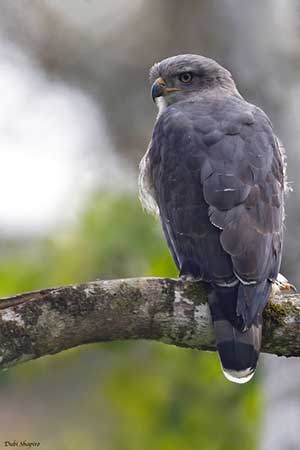
The juvenile has dark brown upperparts. The underparts are white to pale rufous, with brown streaks on throat and breast, and barred flanks. The tail shows narrower dark bars than in adults. The head is streaked dark but the nape is mottled.
The subadult may be paler on the underparts. Head and neck are almost white or grey-brown. Cere and legs are deeper yellow than in adults.
RANGE:
The Southern Banded Snake Eagle has restricted range. It is found in a narrow band within 20 kilometres from the east African coast, from S Somalia, through Kenya, Tanzania and Mozambique, and also into NE South Africa.
Inland, the species occurs in Usambara Mts in Tanzania.
HABITAT:
The Southern Banded Snake Eagle frequents the coastal evergreen forest. It is often found in riverine forest or near water, and in open woodland in marshy areas. It also frequents exotic plantations (Eucalyptus).
The species is visible from sea-level to 1,500 metres of elevation.
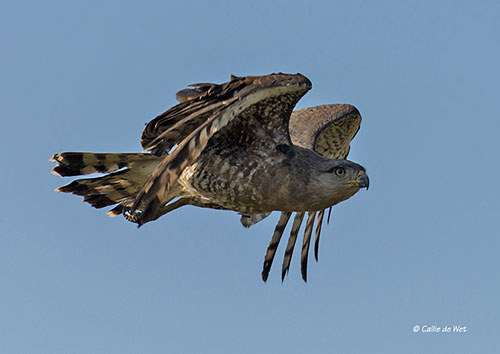
CALLS AND SONGS: SOUNDS BY XENO-CANTO
The Southern Banded Snake Eagle is known as a noisy bird of prey, although being solitary and secretive.
It often gives a fast, high-pitched “ko-ko-ko-ko-kwaaaak” or “kerk kowa” while perched and during the flight displays.
The call is a harsh “crok-crok-crok” and we can also hear a loud, ringing “kowaaaa” and a broken “kurk-urr”.
BEHAVIOUR IN THE WILD:
The Southern Banded Snake Eagle feeds primarily on snakes, lizards, insects such as large beetles, mice and amphibians, and sometimes small birds.
It hunts by perching within the forest canopy, but also occasionally on pylons above cultivated areas and grasslands close to the forest. It hunts mainly in the early morning before to retreat into the forest while the temperatures are increasing.
It hunts by scanning the ground from a perch. When a prey is located, it swoops down and tries to catch it.
Small snakes are swallowed whole and head-first.
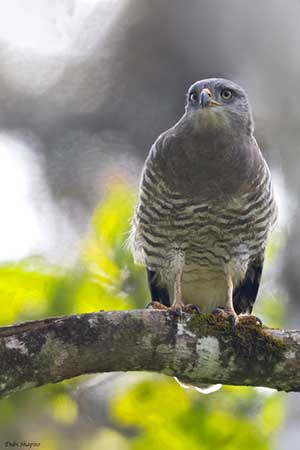
The Southern Banded Snake Eagle is monogamous and territorial during the breeding season.
The courtship displays consist of soaring, dives and calling. They fly up and down while calling loudly, before to finish with a steep dive. The adults build the nest with sticks in tree fork. The single chick is fed by both parents that share most of the nesting duties.
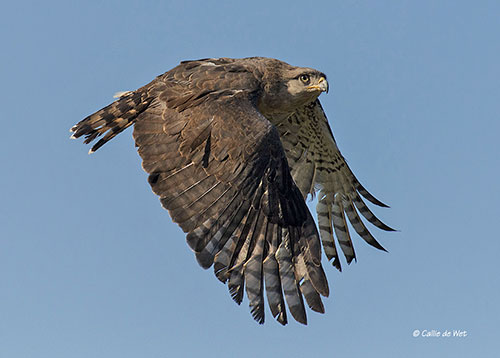
The Southern Banded Snake Eagle is largely sedentary and resident, but some movements N into Kenya may occur during the dry season between May and September.
This raptor is not an accomplished flier with its rather short, rounded wings. However, it flies with rapid, shallow wingbeats and even soars when possible.
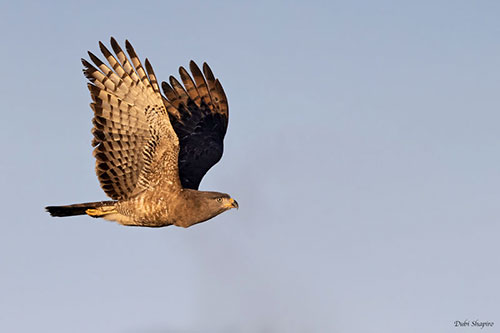
REPRODUCTION OF THIS SPECIES:
The breeding season takes place between July and October in East Africa and between August and October in Southern Africa.
The Southern Banded Snake Eagle is territorial and proclaims its territory with aerial displays accompanied by loud calling.
The nest is about 50-70 centimetres wide. It is made with sticks and twigs, and lined with some green leaves. It is placed in tree fork, 8-13 metres high in the forest canopy, usually protected by creeping plants.
The female lays a single greenish-white egg with rufous streaks. She incubates usually alone during 49-51 days, although the male may help at the beginning of this period.
After hatching, the chick is fed by both parents with shredded snake flesh, but the female stays at nest during some days while the male hunts for the family. Later, both adults hunt together to feed the young. Information is lacking about nesting and fledging periods.
The chick may be sometimes taken by the African-fish Eagle.
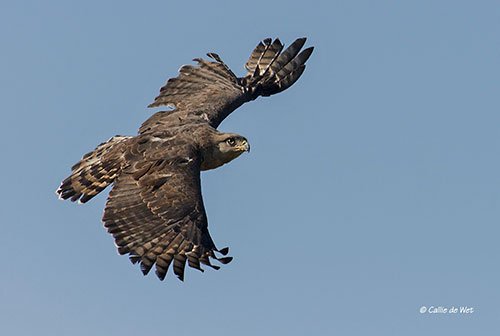
PROTECTION / THREATS / STATUS:
The Southern Banded Snake Eagle is threatened by habitat loss caused by deforestation, degradation and fragmentation of coastal forests, especially along rivers, for wood extraction. Slash-and-burn agriculture is a threat for the forest, and the loss of both cultivated areas and plantations has involved local declines.
The population is roughly estimated to number 670/2000 mature individuals.
In South Africa, only 40/50 pairs are thought to occur, due to small, fragmented distribution and habitat destruction.
Conservation efforts to manage deforestation and habitat degradation are in progress throughout most of the range.
But currently, the Southern Banded Snake Eagle is classified as Near Threatened.
